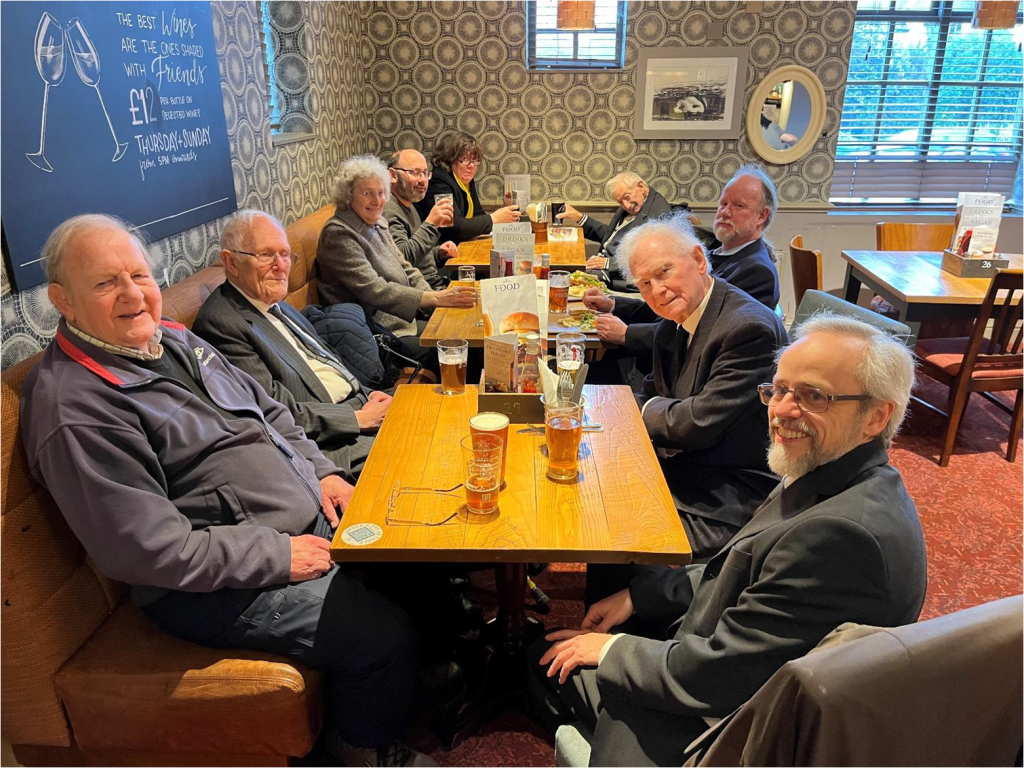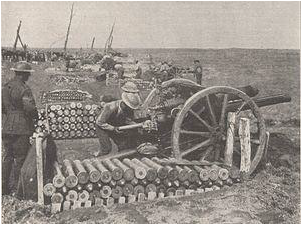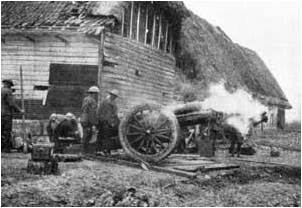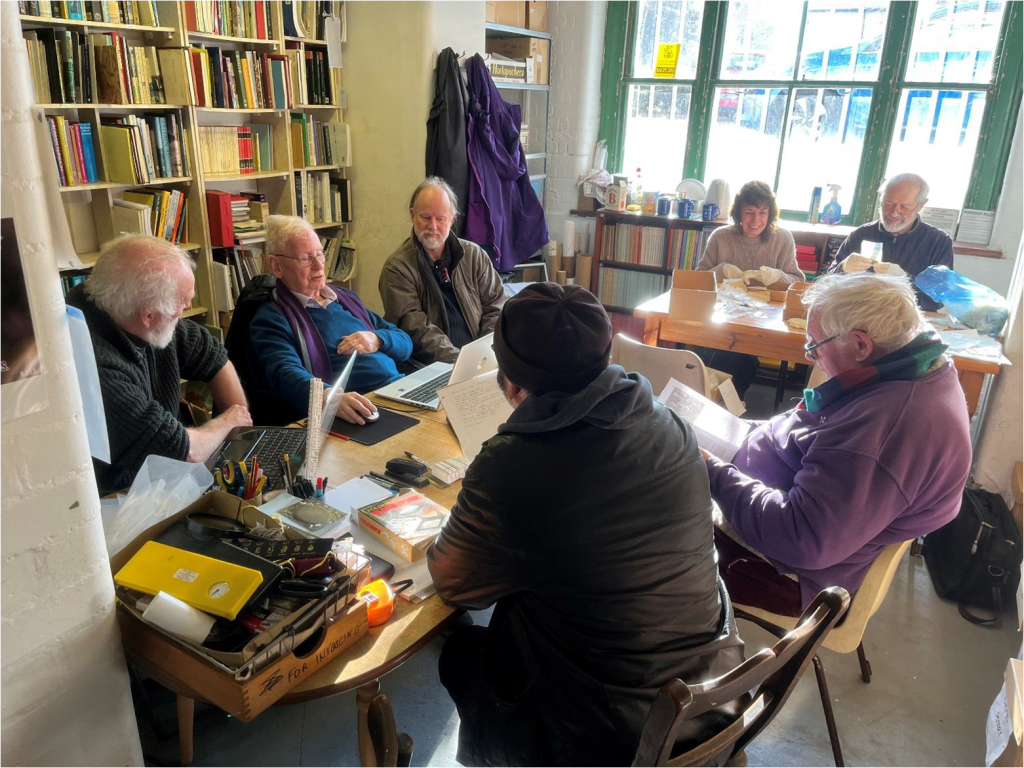
No. 623 February 2023 Edited by Andy Simpson
________________________________________________________
HADAS DIARY – Forthcoming Lectures and Events
We are pleased that we are able to resume lectures face to face following Covid, though lectures in winter may be on Zoom.
Lectures are held in the Drawing Room, Avenue House, 17 East End Road, Finchley N3 3QE. 7.45 for 8pm.
Buses 82, 143, 125, 326 and 460 pass close by, and it is a five-ten minute walk from Finchley Central Station on the Barnet Branch of the Northern Line. Bus 382 also passes close to Finchley Central Station.
Tea/Coffee/biscuits available for purchase after the talk.
Tuesday 14 February 2023 The Dorothy Newbury Memorial Lecture: Signe Hoffos: ‘Bombed Churches of the City (WWI and WWII air raids and the City of London churches)’
Signe has spoken to HADAS before on other aspects of City churches, and several of us know her through the City of London Archaeological Society – CoLAS.
Tuesday 14th March 2023 Robin Densem (HADAS): ‘A Career in Ruins’ – Robin will talk about his career in Archaeology
Tuesday 11th April 2023 Robert Stephenson (Also with CoLAS): ‘The Thames; It’s Myths and Mysteries’
Tuesday 9th May 2023 Bill Bass: ‘Hopscotch in High Barnet: A HADAS dig’
Several of us worked on this short but enjoyable ‘backyard’ dig last year, directed by Bill, and the report is being serialised in the newsletter.
Tuesday 13th June 2023 HADAS Annual General Meeting
Followed by a lecture
1
FUNERAL OF STEPHEN BRUNNING
Steve’s funeral took place at Hendon Crematorium on Friday 6 January. The weather was kind with sunshine interrupting the rain and some 16 HADAS members attended. The humanist service included some of Steve’s favourite music, by Emmylou Harris, Joni Mitchell, and Enya. Celebrant Debbie Coe read memories of Steve by long-time evening class leader Jacqui Pearce and Chairman Don Cooper (see below), and the nicely illustrated order of service included a photo of a clay pipe alongside pictures of Steve to mark a particular interest of his.
Thanks to Jacqui Pearce for this order of service picture of Steve who was a proud member of the CIfA.
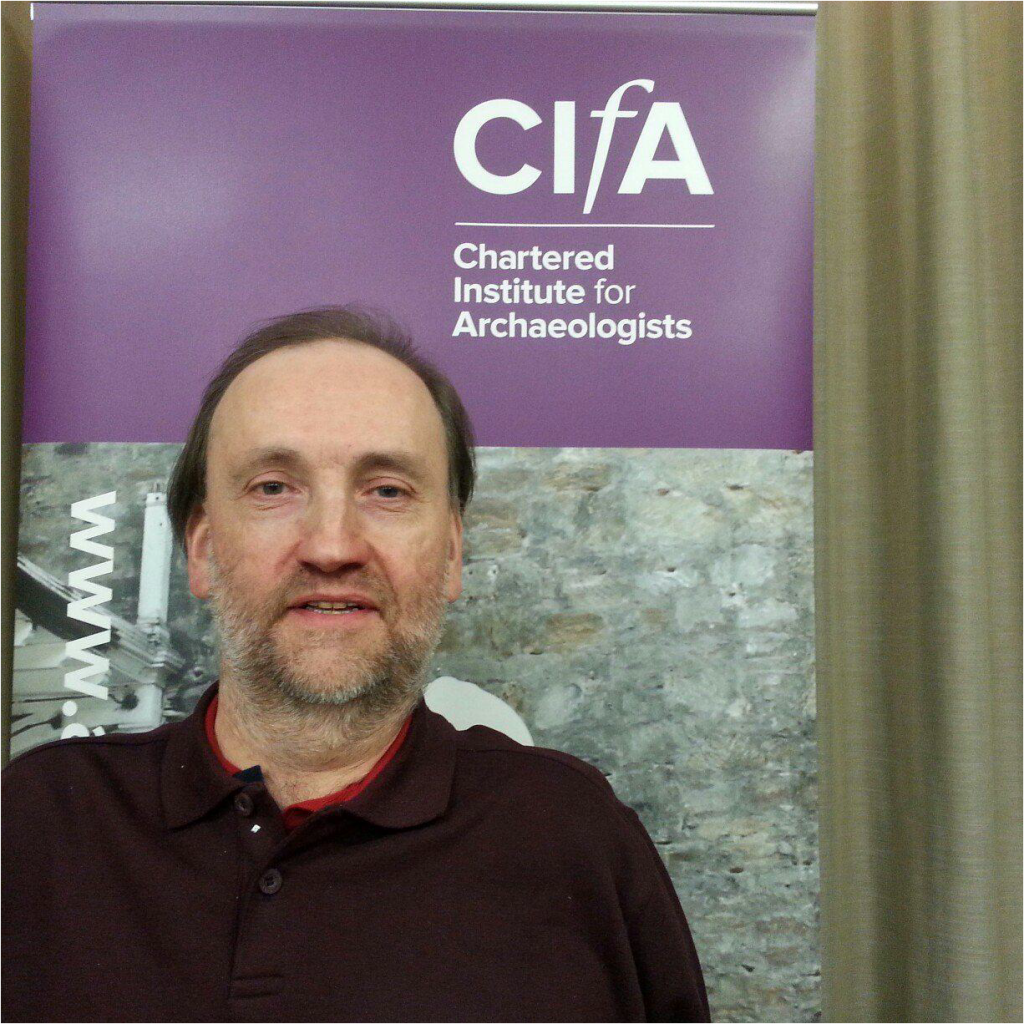
2
At Steve’s funeral, the celebrant read out these tributes to Steve from Evening class tutor Jacqui Pearce and HADAS chairman Don Cooper …
Jacqui Pearce
I first came to know Steve about 20 years ago, when he joined the Birkbeck evening classes in archaeological post-excavation work, which were being held at Avenue House in Finchley. He signed up for the very first course and for every single course since then, including all those run under the auspices of HADAS from 2009 onwards until 2020, when they finally came to an end. There were times when his health made it difficult for him to attend, but he was always fully involved with everything we were doing and was hugely helpful and supportive whenever he was with us. He loved looking at archaeological finds and had a particular interest in the study of clay tobacco pipes, which he made something of a specialism, writing up the pipes from Church End Farm and Church Terrace for the two publications that the Finds Class produced. This is why we’ve included a photo of a clay pipe in the Order of Service, in case you were wondering!
Steve had a genuine passion for archaeology and did all he could to promote, study and further the cause. I remember how delighted he was when he was accepted into the Chartered Institute for Archaeologists as an Associate, something which came about because he was proposed and supported by an existing Member who could vouch for his credentials. In fact, he became Editor of the Institute’s Newsletter, no mean achievement! He had a probing mind and was very thorough in everything he did for archaeology, always wanting to find out more and always asking questions. And he did this in a very unassuming way, never self-regarding, never promoting himself above others.
Steve was a very gentle and courteous man, and it was a real pleasure to spend time in his company. Over the years I knew him his health deteriorated noticeably, and he always bore this with courage and maintained a positive attitude as much as he possibly could, even through the incredibly difficult time when he lost his father. I never heard him get angry or impatient with anyone, even when he was finding life tough. As much as he could, he wanted to help other people and it was always a pleasure to spend time with him. And one more bond we had was a shared love of Star Trek! Although we never spoke about it, he did talk to my daughter about the music he loved and the choices we are listening to today are based on her recollections of conversations she had with him.
My recollections of Steve started with his love of archaeology, and he played a very important part in the Hendon and District Archaeological Society, which I haven’t covered in any depth. For this, I’d like to hand over to Don Cooper …
Don Cooper
Steve had a great interest in all things archaeological especially ceramic clay pipes and joined HADAS as a member in November 1998.
He was elected onto the Committee in June 2004 and served as a committee member continuously up to the present.
He took on the office of membership secretary in 2008. This involved maintaining the database of members, keeping their subscriptions up to date, producing address labels files for the newsletter and preparing Gift Aid returns for the Treasurer.
He also organised the annual lecture series – booking the speakers and venue.
He was an invaluable member of the committee.
Over and above all that he was a kind, helpful participant in HADAS’ activities and I well remember his successful contributions to many a Quiz night.
He will be greatly missed. Rest in Peace, Steve.
3
Afterwards a number of HADAS members and fellow evening class students (Hello Jeremy!) who had attended the funeral raised a glass or two to Steve’s memory at the Three Hammers pub on Mill Hill Ridgeway…
(photo; Andy Simpson)
January Lecture Report – History Underfoot: Britain’s Industrial Heritage in Barnet Streets by David Willoughby.
Drawing on knowledge acquired through his membership of the Greater London Industrial Archaeology Society (GLIAS), David very kindly stepped in when the previously advertised speaker was unavailable and gave twenty or so HADAS members this most informative lecture via zoom. He reminded us when walking around Barnet to look down as well as up for heritage artefacts hiding in plain view. He began by discussing coal plates (known as Opercula) – holes in the pavement or in front of houses for coalmen to deliver coal to cellars below. The covers were square and made of stone in Georgian times, later usually circular and of cast iron. Many were made in Birmingham and Wolverhampton as well as bearing the markings of London foundries and ironmongers, such as the St Pancras Ironworks. He also discussed Sir Henry Bessemer and his steel production process and Mariott Brothers of Barnet, who were builders and contractors 1881-2; some of their coal plates were produced at a foundry in Shoreditch.
Next discussed were utility covers for water mains, sewers, gas mains, fire hydrant point covers, Post Office Cables and stopcock coves for instance. Another example was those of ‘Northmet’ – the North Metropolitan Electricity Power Supply Co, with their power station at Brimsdown, Enfield and offices in Wood Green.
4
Drain covers were discussed in some detail, especially those produced for local councils – including Potters Bar Urban District Council and Barnet London Borough Council, formed only in 1965. This also included detailed discussion of individual manufacturers and their history. Other ironwork discussed included gates and railings, post(pillar) boxes, and of course Stink Pipes as recently discussed in some detail by Dudley Miles in the HADAS newsletter. Miscellaneous items covered included stone and cast iron boundary markers including those for the War Department, and cattle troughs, boot scrapers and Ordnance Survey bench marks. A varied discussion at the end permitted certain members to bring in Barnet station cast iron platform canopies and trolleybus overhead junction boxes…Our thanks to David for this enjoyable and informative talk.
BOOK REVIEW Andy Simpson
Flying Up the Edgware Road The birth of North-West London’s Aviation Industry Mark Amies
Published by Amberley Publishing 2022. Softback, portrait format. 168x232mm, 100 colour and monochrome images and maps. ISBN 978 1 3981 0946 9.
This handily sized 96-page book covers exactly what it says on the tin/title, and in considerable detail. It records how this area of North-West London became a hub of the British aircraft industry in the early years of the twentieth century, from the Edwardian suburb of Cricklewood north towards the then semi-rural hamlets of Colindale and Kingsbury.
They played a vital role in aircraft production during the First World War, but companies such as The Aircraft Manufacturing Co. Ltd (Airco) and the Grahame White Aviation Company led by the charismatic Claude Grahame-White declined rapidly by the early 1920s as government orders for new aircraft were slashed overnight. Others such as Handley Page and de Havilland maintained a presence into the 1960s on reduced sites minus their former airfields at Clitterhouse and Stag Lane. Hendon aerodrome of course vanished beneath the Grahame Park Estate in the late 1960s but retains the Royal Air Force Museum which recently celebrated its 50th Anniversary on that site. The industrial buildings themselves often remained in other uses, and some survive today as shown in specially taken modern day colour photographs which record a few precious survivors amongst the ever-growing forest of huge residential tower blocks that nowadays line the Edgware Road.
Historical footnotes such as the very short lived Hendon Factory railway running around the edge of Hendon aerodrome are covered, and we are reminded that a hot air balloon landed in Mill Hill as early as 1862, and the Welsh Harp was an early aviation centre with unsuccessful aircraft trials nearby in 1908, barely five year after the Wright brothers first successful powered flight in 1903. By 1912 Hendon Aerodrome, then known as London Aerodrome, was a flourishing social centre and hub of flying training and demonstrations. Smaller component manufacturers are given due record too.
At Cricklewood Aerodrome, Handley Page Transport Ltd flew international flights to Paris from 1919 using converted bombers and versions developed from them until the airfield was mostly sold for housing in 1929-30. Even the much-reduced Metropolitan Police training facility on Aerodrome Road, Colindale and its successor tower blocks stands on the site of the short-lived London Flying Club, another Grahame-White venture.
Other photographs concerning the local aviation industry incidentally survive in the recently sorted and listed HADAS photographic archive at Avenue House, including a rare shot of the main Titanine Paints building in Sheaveshill Avenue, Colindale.
I would heartily recommend this book to anyone with an interest in the industrial history of our area.
5
‘His Name Liveth For Ever in Hendon’ Andy Simpson
Whilst in Greece on the latest Salonika Campaign Society battlefield tour in September 2022, one of our regular Commonwealth War Graves Commission (CWGC) cemetery visits brought to my attention a native of Hendon who was laid to rest in Salonika (Lembet Road) Military Cemetery, Thessaloniki in Northern Greece, known as Salonika during WW1. He was a member of the British Salonika Force (BSF), engaged in fighting alongside Greek, French, Russian, Italian and Serbian troops against Bulgarian and German troops in Greece and what is now the Republic of North Macedonia in the Balkans.
At the invitation of the Greek Prime Minister, M. Eleftherios Venizelos, Salonika was occupied by three French Divisions and the 10th (Irish) Division fresh from the debacle at Gallipoli in October 1915. Other French and Commonwealth forces landed during the year and in the summer of 1916, they were joined by Russian and Italian troops. In August 1916, a Greek revolution broke out at Salonika, with the result that the Greek national army came into the war on the Allied side. The campaign continued until an armistice was signed in October 1918, some weeks before that on the Western Front.
For details of the campaign see www.salonikacampaignsociety.org.uk
The Hendon soldier was Gunner Ralph Henry Byatt, service number 35729.
Luckily a partial service record for him does survive, athough incomplete and fire damaged in places as are so many other WW1 personnel records since only some 40% of the First World War Army Service Records survived the Second World War bomb damage in September 1940, when during the London Blitz the War Office repository in Arnside Street was hit.
Whilst employed as a Plumber’s Mate, he had enlisted in peacetime London, having attested (swearing allegiance to King George V) on 27 July 1911 with the Royal Regiment of Artillery (Royal Garrison Artillery) Territorial Force, Special Reserve, height recorded as 5ft 6 inches, with fresh complexion, blue eyes and light brown hair.
The Special Reserve was established on 1 April 1908 as a semi-professional force to maintain a reservoir of manpower as reinforcement drafts for the regular British Army serving overseas in wartime and training these replacement drafts in times of war. Reservists enlisted for a six-year term of service and had to undergo six months of basic training on recruitment and three to four weeks training annually. This presumably explains why for the 1911 census Ralph is recorded as being resident in barracks on the night of the census, Sunday April 2nd 1911, his age recorded as 17. At this point he was part of the 6th Battalion Royal Fusiliers according to the census entry. The 6th (Reserve) Battalion Royal Fusiliers was part of the Special Reserve, based in Hounslow.
By 1917 Ralph was serving with the heavy howitzer-equipped 130 Siege Battery part of the 9th Brigade of the Royal Garrison Artillery, which had been in Salonika since August 1916, having four of the recently introduced 26cwt, six-inch calibre howitzers on strength.
Their role was mainly to provide plunging high explosive fire to soften up enemy defences prior to an infantry attack, and also to target opposing heavy artillery batteries in counter battery fire.
However, with supply of men and material always an issue, there were never more than a few dozen of these weapons available to the BSF.
The Siege Batteries of the Royal Garrison Artillery – The Long, Long Trail (longlongtrail.co.uk)
6-Inch 26 cwt (militaryfactory.com)
BL 6-inch 26 cwt howitzer – Wikipedia
6
As a Gunner his rank was equivalent to a Private.
He died on Wednesday, 10 January 1917, aged 25. Confusingly however, his pension record card gives a date of 10 April 1918, killed in action.
The son of Sandon-born 44-year old Hendon Urban District Council carman (horse drawn cart driver) Arthur and his 42-year old wife, Henlow-born ‘charwoman’ Emma Byatt of 15, Heading Street (Off Church Road), Hendon, he was actually a native of the village of Sandon, Hertfordshire, where he was baptised on the 14 April 1895. Father Arthur Edward Cornelius Byatt. Ralph was one of three children, his parents having by then been married for 20 years.
His mother Emma was awarded a pension of 5/6d a week payable from 29 October 1918, along with £8 10s 1d unclaimed pay and a war gratuity of £14. A soldier’s pay that had been credited to his account but not issued to him, along with any gratuities, were eventually distributed in accordance with his will.
The war gratuity would be paid to every warrant officer, non-commissioned officer and man who served with the army or air force, either voluntarily or compulsorily, since 4 August 1914, and to the legatees or next of kin of those who had lost their lives with some exceptions. There was a minimum payment of £5, with various increments for length of service, and was issued in the form of a Post Office Savings Bank Book deposit.
War gratuity – The Long, Long Trail (longlongtrail.co.uk)
For his gravestone, his grieving parents chose (and had to pay for, as was standard practice) a personal epitaph for his standard CWGC headstone ‘ His Name Liveth For Ever In Hendon. Mum and Dad’ This is a variation on the phrase “Their name liveth for evermore” is a phrase from the King James Version of the Bible, forming the second half of a line in Ecclesiasticus or Sirach, chapter 44, verse 14, widely inscribed on war memorials since the First World War. See Their name liveth for evermore – Wikipedia. The message had to be composed from a maximum of 66 characters including spaces. Each character used cost the family 3½d. The 37 letters in this inscription cost his parents 10s 9d, equivalent to some £22 at 2022 prices.
The Cemetery is located at 192 Langada Street, on the Serres highway approximately 2 km north of Thessaloniki city centre on the west side of the street. The cemetery is inside a very large, mainly First World War Allied cemetery containing Serbian, French and Italian casualties and is known locally as ‘’Zeitenlik’’ and is to the rear of the Serbian, French and Italian sections.
The city of Salonika was the base of the British Salonika Force and it contained, from time to time, eighteen general and stationary hospitals.
The earliest Commonwealth burials took place in the local Protestant and Roman Catholic cemeteries. Salonika (Lembet Road) Military Cemetery (formerly known as the Anglo-French Military Cemetery) was begun in November 1915 and Commonwealth, French, Serbian, Italian and Russian sections were formed. The Commonwealth section remained in use until October 1918, although from the beginning of 1917, burials were also made in Mikra British Cemetery.
After the Armistice, some graves were brought in from other cemeteries in Macedonia, Albania and from Scala Cemetery, near Cassivita, on the island of Thasos.
There are now 1,648 Commonwealth servicemen of the First World War buried or commemorated in this cemetery. The Commonwealth plot also contains 45 Bulgarian and one Serbian war graves.
7
The Church End area of central Hendon once featured a densely-packed area of Victorian terraced houses and workshops running down to Sunny Gardens and up to Church Walk, centred around the now lost or re-routed Prince of Wales Road, Heading Street, and Fuller Street. They were cleared in the years around 1970 and replaced mostly by low-rise council flats.
Ralph is one of 362 First World War casualties from Hendon commemorated on the still extant Grade-2 listed Hendon War Memorial now sitting rather isolated on an island on the A41 Watford Way by the junction with The Burroughs and Station Road. Costing £185, paid for by private contributions and Hendon Urban District Council, and with a military presence and large crowd attending, this was dedicated by the Bishop of Willesden on 23 April 1922 – appropriately enough, St Georges’ Day, and was resited in 1962 as part of a Watford Way improvement scheme.
On the front and left faces of the memorial, on bronze plaques, are listed the 224 names of those of the Central Ward of Hendon who died in WW1, and on the right face, a similar bronze plaque lists the 138 names of the West Ward of Hendon. All the names are listed alphabetically by surname, followed by first names and any further initials, without any ranks of units.
(All recent photos by Andy Simpson)

8
From the names listed on the memorial it would seem that at least three other former residents of Hendon lie at rest in Greece having served in the Salonika Campaign, two of them in the same cemetery; See Roll of Honour – Middlesex – Hendon (roll-of-honour.com)
All four men came from solid working-class backgrounds (two of them with fathers employed by Hendon Council) and only one of them attained even junior NCO rank during their service; they were truly the lost rank and file generation. They are further discussed individually below.
Gunner Robert Franklin, service number 58207
Royal Horse Artillery/Royal Field Artillery 11th Battery, 1st Brigade;
Died of wounds Friday 4 May 1917 aged 21; buried in Struma Military Cemetery.
I Brigade of the Royal Field Artillery – The Long, Long Trail (longlongtrail.co.uk)
Son of Robert and Emma Franklin, of 3, Salisbury Plain, off Brent St, Hendon.
Headstone inscription; GONE BUT NOT FORGOTTEN MOTHER
Only his Medal record card, soldier’s effects record, Grave Record, and Dependent’s Pension card seem to survive.
Christened at St Mary’s Church Hendon on 11 December 1895, in the 1911 census his father Robert was a 52-year-old general labourer at the Hendon District Council sewage farm, which had opened at Clitterhouse as a sewage outfall works in 1886, extended in 1913 and closed in 1935; (interesting that he was another Hendon UDC employee, like Ralph Byatt’s father) his mother Emma being the same age; they had been married 33 years and were both born in the village of Yelling, Huntingdonshire, which in 1911 had just 246 inhabitants. They had nine children, the first three born in Gelling, of whom seven survived.
In 1911, 15-year-old Hendon-born Robert was living at home as a printer’s apprentice.
He had served initially in France from 6 September 1915, and therefore qualified for the 1915 Star and War and Victory Medals. His soldier’s effects record indicates that he died in the field and that pay of £19 4s and war gratuity of 10 guineas was credited to his mother.
From 6 November 1918, his mother Emma was granted a pension of 5s a week.
1 Brigade was a unit of Britain’s pre-war regular Army; it went to France in December 1914 and on to Salonika in late 1915, presumably taking Robert Franklin with it as part of 27th Division.
A word here perhaps about the structure of the British Army during the Great War;
The smallest unit in an army is the squad, which contains 7 to 14 soldiers and is led by a sergeant (A slightly larger unit is a section, which consists of 10 to 40 soldiers) Three or four squads make up a platoon, which has 20 to 50 soldiers and is commanded by a lieutenant. Two or more platoons make up a company, which has 100 to 250 soldiers and is commanded by a captain or a major.
Two or more companies make up a battalion, which has 400 to 1,200 troops and is commanded by a lieutenant colonel. The battalion is the smallest unit to have a staff of officers (in charge of personnel, operations, intelligence, and logistics) to assist the commander. Several battalions form a brigade, which has 2,000 to 8,000 troops and is commanded by a brigadier general or a colonel.
9
A brigade is the smallest unit to integrate different types of combat and support units into a functional organization. A modern combat brigade, for example, usually has infantry, armoured vehicles such as tanks, artillery, and reconnaissance units. Two or more brigades, along with various specialized battalions, make up a division, which has 7,000 to 22,000 troops and is commanded by a major general A division contains all the arms and services needed for the independent conduct of military operations. Two to seven divisions and various support units make up an army corps, or a corps, which has 50,000 to 300,000 troops and is commanded by a lieutenant general. The army corps is the largest regular army formation, though in wartime two or more corps may be combined to form a field army (commanded by a general), and field armies in turn may be combined to form an army group.
The original Struma cemetery plot, Plot I, was set too close to a ravine and the graves in it were moved after the Armistice to the present plots VIII and IX.
The remainder of the cemetery consists almost entirely of graves brought in from the battlefields, from the churchyards at Homondos, Haznatar and Kalendra, and from little front-line cemeteries (established by Field Ambulances or Battalions), of which the chief were those at Ormanli (24 burials), Dolab Wood (17 burials) and Big Tree Well (on the right bank of the Struma, opposite Ormanli; 17 Burials)
The Struma River flows through Bulgaria southward to the Greek frontier, then south-east into the Aegean Sea. From the Allied base at Salonika, a road ran north-east across the river to Seres, and it was this road that the right (eastern) wing of the British sector used for the movements of troops and supplies to the Struma front during the Salonika Campaign. For two years or more until the final allied advance in September 1918, fighting in the Struma featured outposts, raids and patrols, with the main British and Bulgarian positions either side of the malaria-ridden valley.
In the autumn of 1916, the 40th Casualty Clearing Station was established not far from the road near the 71 Kilometer stone and the cemetery made for it was originally called Kilo 71 Military Cemetery.
Struma Military Cemetery contains 933 British casualties of the First World War, 51 of them unidentified. There are also Indian, West Indian, Maltese, Greek, Bulgarian and Turkish war graves located there.
Australian gun crew with standard British 18-pdr field gun as used by some of the Hendon soldiers discussed, Ypres sector, 1917.
10
6-Inch calibre 26 Pdr. Howitzer – a type the Hendon men were also familiar with.
Struma Military Cemetery
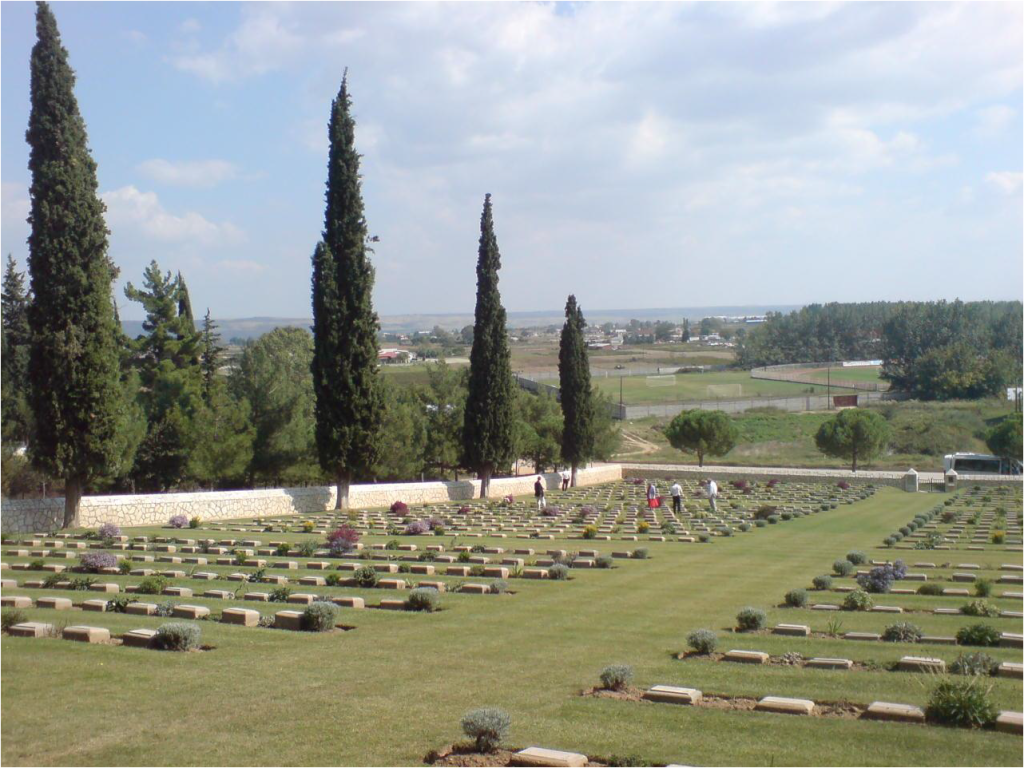
11
Gunner Stafford Lawrence Lindsell, service number 163587;
Royal Field Artillery, ‘B’ Battery, 116th (CXVI) Brigade;
Died of wounds Saturday 17 November 1917, aged 20; buried in Karasouli Military Cemetery.
Personal Inscription LOVING SON, BROTHER KIND
Baptised in Hendon 18 April 1897, enlisted in Hendon; Eldest son of Stafford and Harriet Lindsell, of 18 Stratford Road, Hendon, London. The Stratford Road houses dated to around 1879. In the1911 census his Essex-born 41-year-old father Stafford was a house decorator. He and 38-year-old Finchley born wife Harriet had been married for 15 years and had nine children, all born in Hendon and all then still living. 14-year-old Stafford Lawrence was then a ‘Dairy Boy’.
CXVI Brigade RFA, sometimes recorded as here as 116 Brigade was formed as part of the raising of Lord Kitchener’s new Third Army in 1914, with each battery equipped with four of the standard 18-pdr field guns (six from December 1916), under the command of the 26th Division. In service since 1904, the quick-firing and reliable18-pounder was the British Commonwealth’s most widely used field gun during the First World War, using high explosive and shrapnel shells to cut barbed wire and impact front line defences and troop concentrations. Its 84mm calibre and shell weight were greater than its French and German equivalents.
The Brigade had moved to Salonika in November 1915, and in April/May1917 fought in the first Battle of Doiran.
Batteries and Brigades of the Royal Field Artillery – The Long, Long Trail (longlongtrail.co.uk)
116 Brigade, Royal Field Artillery in the Great War – The Wartime Memories Project –
Only his soldier’s effects and pension claimant details survive.
His mother Harriet was granted a pension of seven shillings a week from 4 June 1918.She also received £8 10s 1d in unclaimed pay and a war gratuity of £3 10s.
Acting Bombardier Percival (Percy) Frederick John Lemon, service number 49331;
Royal Field Artillery ‘D’ (Howitzer) Battery XCIX (99th) Brigade;
Died of wounds (killed in Action) Friday 26 April 1918 aged 23; also buried in Karasouli Military Cemetery.
Personal Inscription
FATHER IN THY GRACIOUS KEEPING LEAVE WE NOW THY SERVANT SLEEPING
Son of Frederick James and Minnie Lemon of 8 Ramsey Road, West Hendon, London. Houses built around 1900.
99th Brigade RFA was under the command of 22nd Division, which had been formed in 1914 as part of Lord Kitchener’s New Third Army, moving to Salonika in October 1915.
At the time of death, Percy’s rank of Acting Bombardier was equivalent to Acting Corporal, in charge of a section of 7 – 12 men. 99 Brigade, Royal Field Artillery in the Great War – The Wartime Memories Project –
12
Only his dependent’s pension and personal effects records survive.
At the time of the 1911 census, 16-year-old Percy was a domestic gardener living with his 40 year old father Frederick James a labourer, who had been married to 41 year old Minnie (employment recorded as ‘Charing – cleaning) for 18 years, having two children, of whom both then survived.
His mother Minnie received £18 13s 11d in owed pay, a war gratuity of £16 10s and a pension of 5s a week from 6 November 1918.
Percy is the highest ranking of the four men from Hendon.
Karasouli cemetery was begun in September 1916 for the use of casualty clearing stations on the Doiran front. At the Armistice, it contained about 500 burials but was greatly increased when graves were brought in from a number of cemeteries.
All photos by the author.
With thanks to my sister Alison for compiling the available online personnel records.
In time I may also look to trace Salonika casualties from Finchley and Barnet also, so I would be interested to hear of any details readers may know of. I hope to be able to visit and pay my respects at local graves on my future visits to the battlefields, hopefully during the 2024 visit which will study the Salonika Air Campaign in particular.
Karasouli Military Cemetery
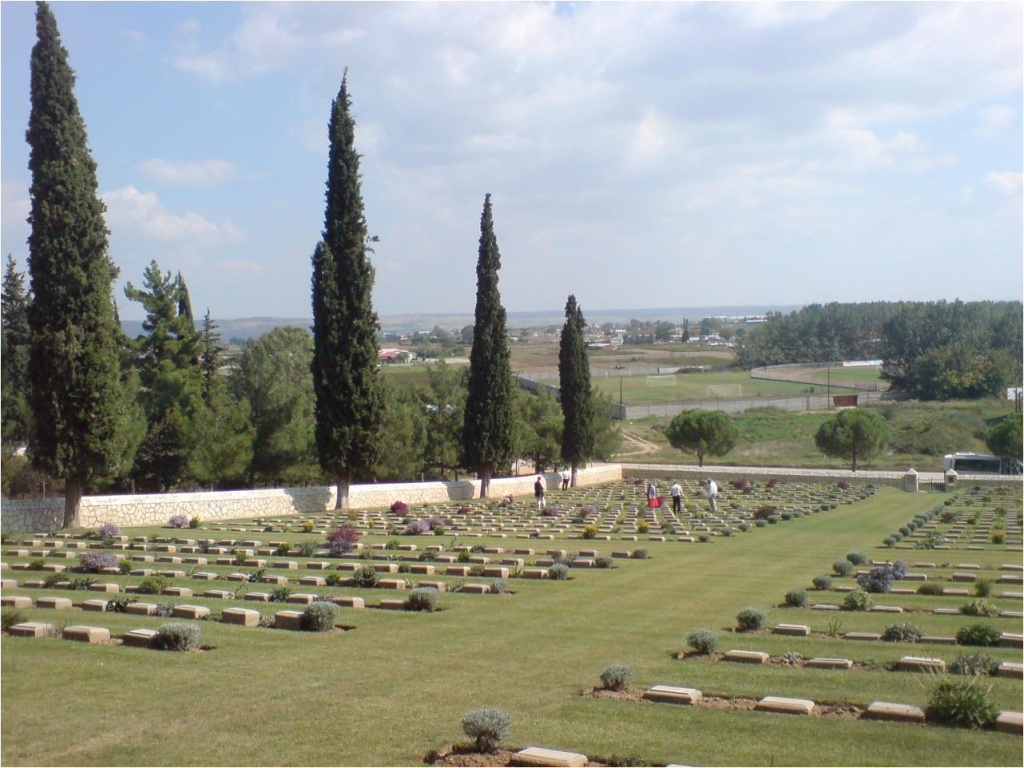
13
HADAS members will remember the hugely enjoyable September 2019 trip to South Wales, so ably organized by Jim and Jo Nelhams. One place we visited was the ‘out of town’ conservation and restoration facility for the remaining hull portions of the medieval Newport ship.
It has recently been in the news again…see link below for an excellent summary and CGI of the ship at sea.
Newport Ship: Medieval vessel is ‘world’s largest 3D puzzle’ – BBC News
Sunday Mornings at Avenue House Andy Simpson
These continue, with much good work being done in sorting and repacking HADAS archive material including many historic local photographs and much ‘History of HADAS’ material featuring past HADAS personalities and trips. There is even a poster for the renowned HADAS Minimart in Hendon, as organized for so many years by the late Dorothy Newbury. Most recently we have just started sorting archives and finds (mostly flint flakes, especially ‘debitage’ waste flakes) from the 1976-85 HADAS excavations on West Heath, Hampstead.
14
Other Societies’ Events Eric Morgan
Not all Societies or Organisations have yet returned to pre-covid conditions. Please check with them before planning to attend.
Saturday 4th February, 10 a.m.-4pm. Elstree and Borehamwood Transport Collectors Fair. Allum Manor House and Hall, 2, Allum Lane, Elstree and Borehamwood, WD6 3RJ. Bus and Railway Memorabilia incl. Models, Books, Photographs, Tickets, Timetables, Ephemera. Admission £3. Refreshments available.
Monday 13th February, 3p.m. Barnet Museum and Local History Society. St. John the Baptist Church, Chipping Barnet, corner High St./ Wood St., Barnet EN5 4BW. Reporting Barnet; Why it is so difficult to find out about Local News. Talk by Nick Jones. Please visit www.barnetmuseum.co.uk.
Wednesday 8th March, 2.30 p.m. Mill Hill Historical Society, Trinity Church, 100, The Broadway, NW7 3TB. Sir John Laing and his Mill Hill legacy. Talk by Alex Finkenrath. Preceded by AGM. Please visit www.millhill-hs.org.uk.
Wednesday 8th March, 6p.m. Gresham College. Viking Pagan Gods in Britain. Talk by Ronald Hutton. Ticket required. Register at What’s On | Gresham College and view on-line. please see Viking Pagan Gods in Britain | Gresham College. Free. In the c9th and c10th the Vikings brought with them their own gods; Odin, Thor, Tyr, Lok and Freya, and left their trace on the British landscape in the form of scenes carved on stone slabs and material evidence in richly furnished graves, esp. on the Isle of Man.
Wednesday 8th March, 8p.m. Hornsey Historical Society. Talk on zoom. Highgate Cemetery – A Historic Cemetery for the c21st. By Ian Dungavell. Please e-mail hornseyhistoricalchairman@gmail.com for link Also visit www.hornseyhistorical.org.uk.
Monday 13th March, 3p.m. Barnet Museum and Local Historical Society. For address. please see 13th Feb. The Woodvilles; Witchcraft and Politics during the Wars of the Roses. Talk by Gemma Holden.
Wednesday 15th March, 6p.m. Gresham College Landscapes of Roman Britain. Talk by Martin Millett. Ticket required. Register at What’s On | Gresham College. and view on-line. Please see Stonehenge: A History | Gresham College . Free. Will explore our current knowledge of the nature of Roman hardware shop Imperialism and the History of Britain.
Wednesday 15th March, 7.30p.m. Willesden Local History Society. St. Mary’s Church Hall, bottom of Neasden Lane, NW10 (round corner from Magistrates’ court). Harlesden Green.in the1870’s. Talk by Margaret Pratt (Gen. Sec.) on the life and times of the Beeson family and their famous hardware shop in Harlesden High St. and recollecting on a childhood in Harlesden Green when it was a small village. The family ran a shoeing forge, ironmongers and wheelwrights in the High St. during the early years of the 20th century. May also be on zoom. If not a member, buy a ticket (£3). For details, please visit www.willesden-local-history.co.uk.
Thursday 16th March, 8p.m. Historical Association; Hampstead and N.W, London Branch. The Historical Arthur. Talk by Prof. Andrew Breeze on the controversial thesis that this classic of Middle Welsh Literature was written by a woman. and argues that he was a historical figure who fought other Celts in battles in Scotland and Northern England in the 6th century. Meet at Fellowship House, 136a, Willifield Way, NW11 6YD. (off Finchley Rd., Temple Fortune). Hopefully also on zoom. Please e-mail Jeremy Berkoff (chair) at jeremyberkoff@mac.com or tel. 07793 229521 for details of zoom link and how to pay (there may be a voluntary charge of £5). Refreshments afterwards.
Tuesday 14th March, 6.30p.m. LAMAS Talk on zoom. A Work in Progress; A new display for The Cheapside Hoard. By Hazel Forsyth (MOL). To be housed in a permanent gallery at the new London Museum in West Smithfield alongside the Worshipful Co. of Goldsmiths’ collection. Please book via www.lamas.org.uk/lectures.html.
15
Saturday 18th March, 10.30a.m.-6p.m. LAMAS Archaeological Conference. Morning session; Recent work in and around the Capital. Afternoon session; Recent work on Roman Towns incl. London. To book please visit www.lamas.org.uk/conferences. This will be on zoom again. Tickets will be available to purchase via the lamas eventbrite website. Early bird before 28th Feb. (£15). Standard tickets (after 1st Mar.) £17.50.
Tuesday 21st March, 8p,m. Ruislip, Northwood and Eastcote Local History Society. Talk should be on zoom. When Horses ran London. By Charlie Forman. For details, please see www.RNELHS.org.uk.
Wednesday 22nd March, 7.45p.m. Friern Barnet and District Local History Society. North Middx. Golf Club, The Manor House, Friern Barnet Lane, N20 0NL. Picture Shows before Cinema. Talk by Ian Christie, Please visit www.friernbarnethistory.org.uk and click on programme or phone 020 83688314 for up-to-date details. (David Berguer, Chair) Non-members £2. Bar available.
Thursday 23rd March, 6p.m. Gresham College. The Medieval Agricultural Revolution.; New Evidence. Talk by Helena Hamerow. Tickets required. Register at What’s On | Gresham College and view on-line. Please see The Medieval Agricultural Revolution: New evidence | Gresham College. Free. Using new evidence from plant and animal remains from archaeological excavations in England linking new forms of cereal farming and the use of the mouldboard plough and systematic crop rotation leading to open-field farming.
Thursday 30th March ,7.30p.m. Finchley Society. Drawing Room, Avenue House, 17, East End Road, N3 3QE. A presentation from the Finchley Society Planning Committee. For further details, please visit www.finchleysociety.org.uk Non-members £2 at the door. Refreshments in interval.
++++++++++++++++++++++++++++++++++++++++++++++++++++++++++++++
With many thanks to this month’s other contributors: Don Cooper: Eric Morgan; Jacqui Pearce. Andy Simpson
++++++++++++++++++++++++++++++++++++++++++++++++++++++++++++++
Hendon and District Archaeological Society
Chairman Don Cooper, 59, Potters Road, Barnet EN5 5HS (020 8440 4350)
e-mail: chairman@hadas.org.uk
Hon. Secretary Janet Mortimer, 34, Cloister Road, Childs Hill, London NW2 2NP
(07449 978121) e-mail: secretary@hadas.org.uk
Hon. Treasurer Roger Chapman, 50, Summerlee Ave, London N2 9QP (07855 304488)
e-mail: treasurer@hadas.org.uk
Membership Sec SITUATION VACANT
For the present, please address any correspondence such as subscriptions, change of member addresses or other miscellaneous correspondence to ;
HADAS, c/o Avenue House 17 East End Road Finchley London N3 3QE
Website at: www.hadas.org.uk – join the HADAS email discussion group via the website.
________________________________________________________________________________________________________________
16

